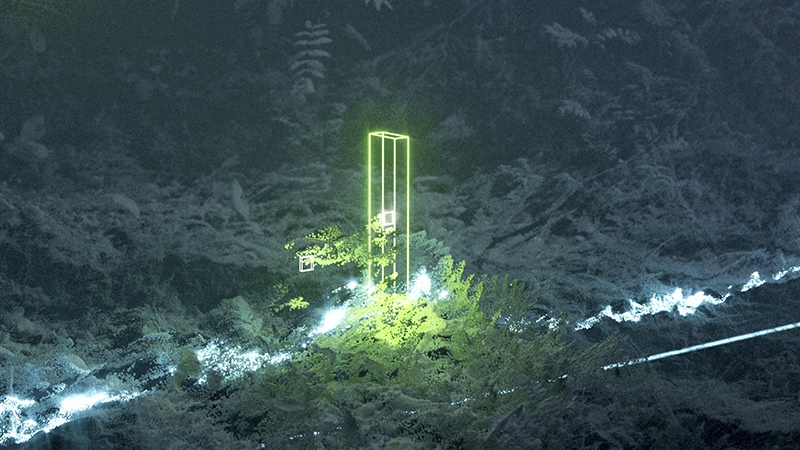Digital Echoes: The Phygital Landscapes of Dan Hoopert
In the contemporary dialogue between the natural world and digital intervention, London-based 3D Artist and Designer Dan Hoopert occupies a compelling space. With a high-profile client roster including Apple, Google, Meta, Nike, and Adidas, Hoopert translates elements of nature into surreal, immersive experiences that challenge perceptual boundaries. His practice is characterized by a sophisticated command of 3D software and a keen eye for realism, employed not merely for replication but to evoke a sense of phenomena – blurring the lines between the tangible environment and its abstract, digital counterpart through intricately crafted visuals and sound.
Hoopert’s unique approach, which often involves reinterpreting environmental data through generative processes, has garnered significant attention, leading to exhibitions in diverse and prominent venues such as the Museum of Applied Arts, the expansive digital canvases of Outernet London, Sonar Festival, and even large-scale billboards in Shanghai. His work invites viewers into meticulously constructed realities where technology becomes a lens to perceive nature anew, revealing hidden patterns and translating physical space into resonant audiovisual landscapes.
In the following conversation, Dan Hoopert shares insights into his self-taught journey, the interplay between algorithmic systems and artistic intuition, and his fascination with using data to reveal the unseen poetry within the natural world.

Q: Can you share a bit about your background and the creative journey that led you to work at the intersection of sound, motion, and digital landscapes?
A: My background is based pretty heavily in 3D design, I am self taught and have been doing this from around the age of 15 so have spent quite a bit of time building skills that allow me to explore various avenues of creating artwork. Over the past few years I have been much more interested in being able to create sound as well as visuals and fell down a rabbit hole of finding ways to achieve this generatively. Looking for ways to establish a direct connection between sound and the visual content I am making.
Q: What initially drew you to the idea of translating spatial environments like forests into sound and visual form? Was there a specific moment or memory that sparked this concept?
A: It’s not necessarily a moment or memory, I think it’s more a result of research. I really enjoy using elements from nature as a starting point for my work, I find it a lot easier to be inspired when I am staring at something that has either been imported from the outside world or a simulated physical process rather than an empty 3D viewport. The project came about when I was looking at lidar scans and experimenting with ways I could use the data to create something new.
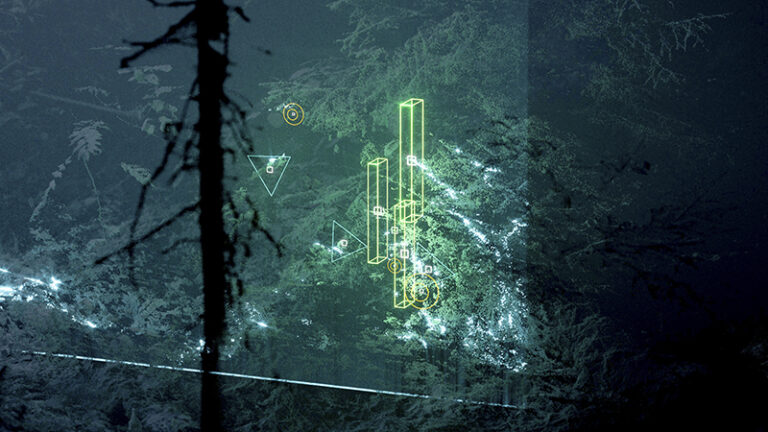
Q: In Audio Synthesis: Through the Forest, how do you see the forest not just as a setting, but as a co-creator in the generative process?
A: I see the forest as a co-creator in the sense that it is giving me the information I need to generate all other elements. From the visuals to the sound everything is derived from the forest in some way. I like the fact that the project is almost just about translating what is already there and giving new form to what already exists within the scanned environment.
Q: Your work blends LiDAR technology, MIDI data, and real-time synthesis. How do you navigate the boundary between algorithmic logic and artistic intuition?
A: With a lot of patience and coffee! [laughs] The process I use to extract the midi data and synthesise sound is far from efficient. It involves exporting various midi clips recorded over the space of the full animation, often resulting in a dense wall of notes that needs to be cleaned up a little bit. I then use these clips to drive different synthesisers and samplers. If all of them are running at once it is a bit of a nightmare so there is quite a bit of curation and parameter tweaking involved to make sure it is not just a complete bombardment of sound and things feel tied to the forest in a natural way. From then it becomes an iterative process of listening and testing different things until something feels right. I’d definitely like to try and make this more of an easier process in future projects.
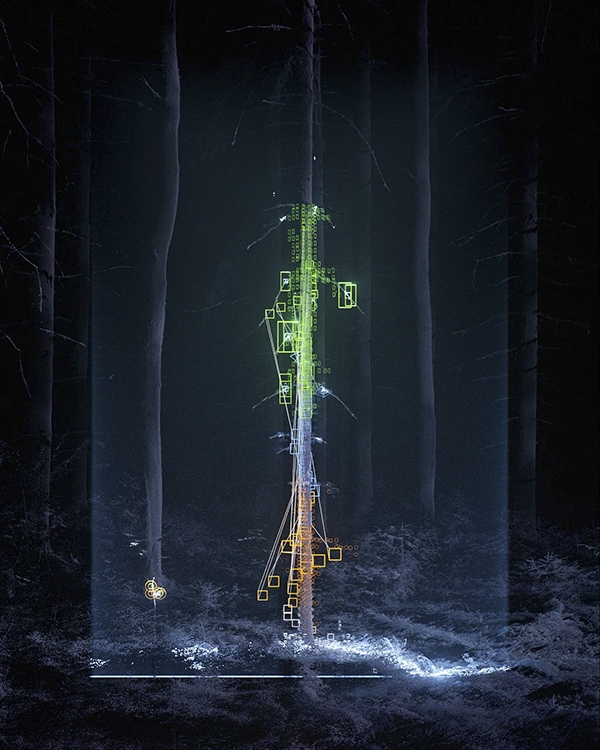
Q: Can you speak to the emotional or atmospheric qualities that emerged from the forest’s unique sonic signature? Were there any surprises in what the data revealed?
A: Something that I found really interesting with some of the data that was generated is that if you zoom out on all the midi notes that are created by the full scan of the forest, you are actually given a musical cross section of all the trees and plants. If you imagine someone trying to draw a tree using sheet music it is very similar to that. It almost looks like a pixelated cartoon drawing of the forest. I’m 90% sure I know why this happens but it also kind of confuses me how well the midi notes trace the outline of what is being scanned. I always thought this was really cool.
Q: You mention the development of an “abstract visual language” generated from data points—how do you interpret or read this language yourself, and do you see it evolving in future iterations?
A: I think this is referring to the graphic shapes that are created. This was something that turned out to be very necessary and really like the role that it serves. When originally testing things out I noticed that just showing the beam of light and listening to the sounds wasn’t enough. Despite things being synced and generated by the scan you kind of need a bit more of a visual cue to understand what is going on. To solve this I created a simple shape language of cubes, triangles and circles with size and colour being tied to the type of sound being generated or certain elements from the scan. I noticed that as soon as you can visually relate specific sounds to shapes and colours things feel a lot more clear. It’s still a bit abstract but definitely helps to tie things together. I’m not too sure how this will evolve. I definitely like the style of these graphic shapes at the moment and I think they do a good job of visually suggesting that there is some kind of computational process going on.
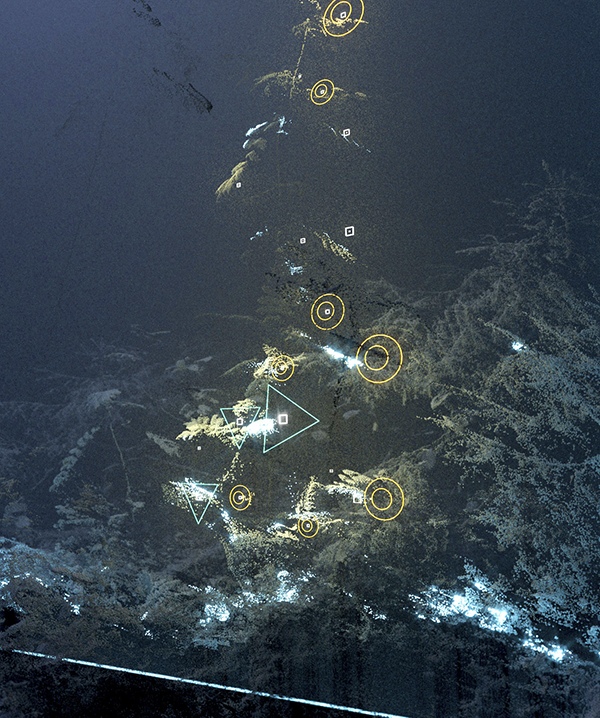
Q: There’s something deeply poetic about using technology to listen to and visualize nature. Do you consider your work a kind of digital ecology, and if so, what role does it play in how we relate to the natural world?
A: I’m not too sure, I really like being able to use this kind of technology to appreciate nature. I think it’s quite nice that a LiDAR scan is a moment frozen in time and allows something to exist forever with a high amount of detail. I’d like to think that it could help people appreciate the surroundings more and maybe have a bit of a contemplative effect, but the main motivation behind creating artwork for me is that I just find it fun and interesting. I enjoy suggesting little things here and there but I’m not too concerned with playing a role in anything at the moment.
Q: In a time when much of the digital world seeks to replicate or replace nature, your installation collaborates with it. Was that a conscious philosophical stance?
A: I don’t think it comes from a philosophical stance, for me it’s more about the fact that I see nature as perfect. If I am using data from any elements of the natural world, whether it is a lidar scan of a forest or a simulation that replicates a biological process I never feel the need to change or edit anything. If I’m then able to dive into these things, extract data like the height of each branch or the curvature of the bark, things that were previously unseen begin to reveal themselves. This can be used to create a tool to drive something new. I like that it becomes more about revealing beauty rather than trying to create it.
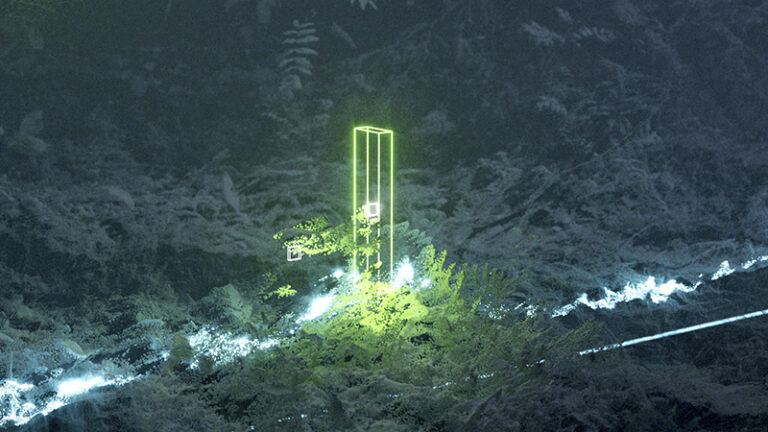
Q: How do you balance unpredictability and control in these generative systems? Do you ever intervene in the output, or is it important to let the forest “speak” without interference?
A: It’s a bit of a tricky one similar to what I mentioned in one of the answers before, there is quite a bit of curation involved. Sometimes just the raw data doesn’t create the most pleasing results and like a lot of generative art systems some outputs are more favorable than others so parameters are adjusted to accommodate that. I am quite strict on the way I do this though and for me the whole point is still very much allowing the forest to ‘speak’. It’s more about letting it speak in lots of different voices and then curating and editing the best bits from that. Everything fundamentally stems from the forest; certain outputs are simply interpolated and emphasized in slightly different ways.
Q: Sound has a temporal nature, and forests change across seasons—do you imagine this installation as something that could evolve over time with different environmental data?
A: I’ve not thought about it but I really like this idea, I’d love to incorporate something like this into future research.
Q: What do you hope a viewer—or listener—takes away from the experience of standing within this rotating library of light, sound, and encoded landscape?
A: I think about this sometimes and I am honestly not too sure. I want people to enjoy it, but mainly just think about it. That’s what I like about art as a language. I’m interested in conveying the little feeling of finding something interesting or exciting because that’s what I felt making it. At its core it’s something I thought was cool that I wanted to make and share. At the same time I believe it has the depth to potentially get people thinking about ideas connected to nature and the forest itself and I enjoy playing on that, but I always want that sort of thing to be quite open ended and am always really interested to hear different reactions. If it’s enough to make someone stop and think about something else for 2-3 minutes I am happy.
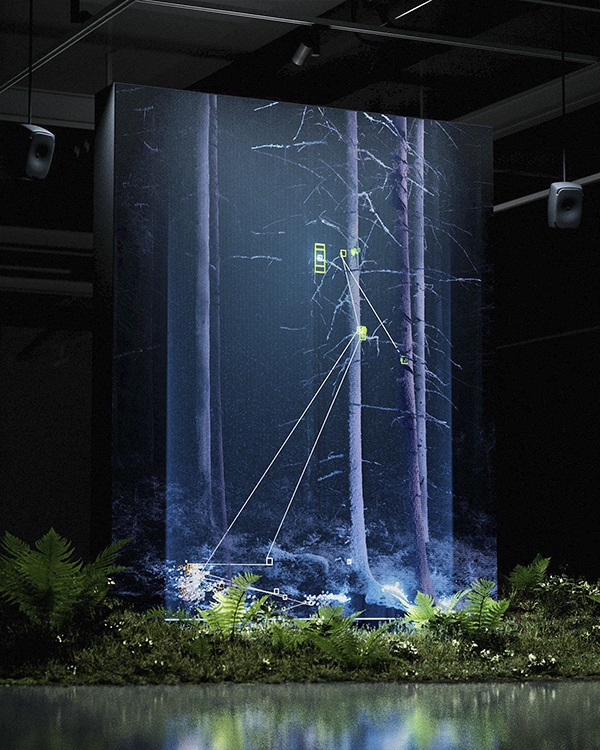
Conclusion
Through this dialogue, Dan Hoopert unveils a practice deeply rooted in both technical innovation and a profound respect for the natural world. His digitally rendered landscapes, born from meticulous LiDAR data and brought to life with generative sound, offer more than mere representation. They invite us to listen to and see nature anew, translated through a technological lens that reveals hidden harmonies. Hoopert’s work, at its core, is about a symbiotic relationship between the digital and the organic, where code becomes a conduit for exploring the inherent poetry of the physical world. In his phygital ecosystems, the forest speaks in a language of light and sound, and the viewer is invited to contemplate not only its beauty but also the intricate systems that connect us to it.
